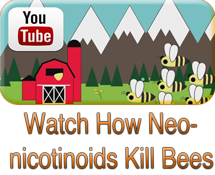26 January 2015 Thiacloprid enhances honey bee's susceptibility to diseases
26 January 2015 Thiacloprid enhances honey bee's susceptibility to diseases
The 3 well-known imidacloprid, clothianidin and thiamethoxam neonicotinoids have been broadly studied in independent literature. The interest scientists gave to these substances and the results they obtained on their toxicity to bees were one of the reasons of their partial ban in the European Union.
2 supposedly less toxic neonicotinoids (thiacloprid and acetamiprid) are still authorised for bee attractive crops. The reason why they are considered safer to bees is that their acute toxicity is fare smaller than that of the banned ones. Actually, very little is known on their chronic and sublethal effects to bees.
In this study, the authors have fed adult bees and bee larvae with feed contaminated with field-relevant doses of thiacloprid. They were inoculated with either the black queen cell virux (BQCV) or the fungus Nosema ceranae. The results show that thiacloprid enhances the lethality of these two pathogens.
One conclusion of this study could be: "beekeepers should control better their pathogens". Actually, Nosema ceranae and BQCV are naturally present in the majority of the colonies, without inducing any symptom: bees deal perfectly with them. The presence of thiacloprid in bees' diet is, on the contrary, not something physiological.
These results confirm those of another study (Alaux et al. 2010) on the interaction between thiacloprid at field-relevant dose and Nosema ceranae.
To the abstract of the article (restricted access).

